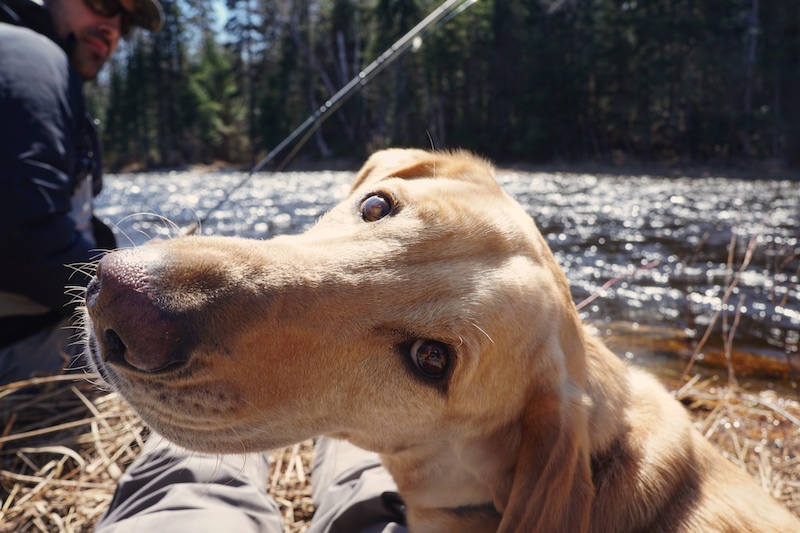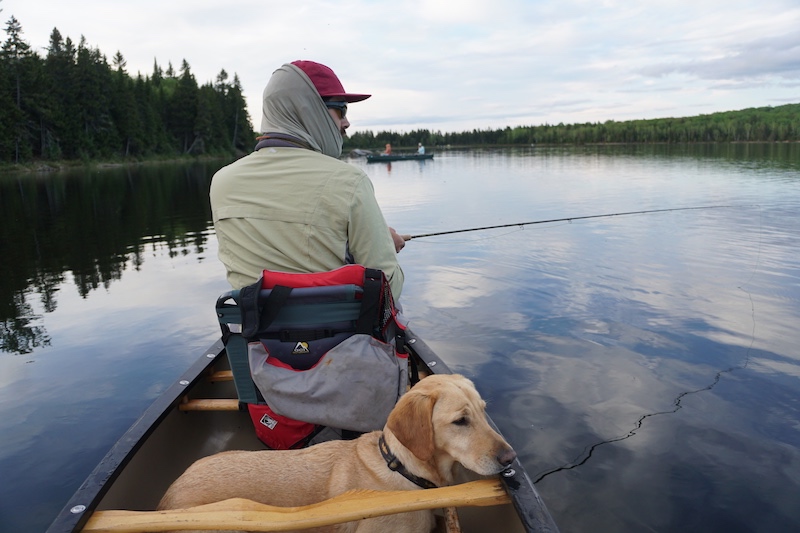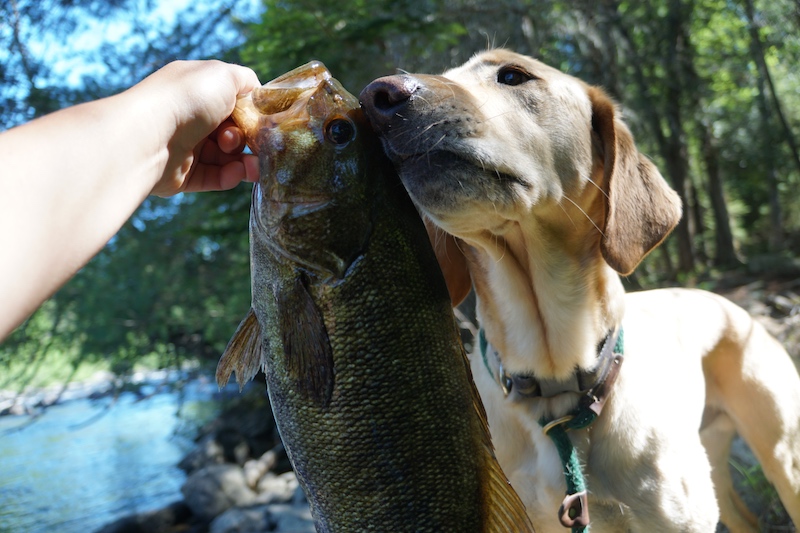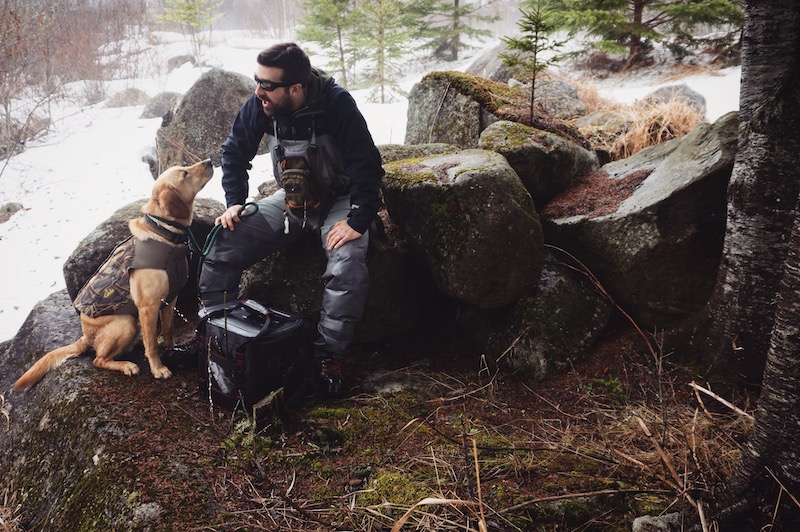
There are few fishing buddies who will tolerate the 100th time I say “one last cast!” or endure early spring canoeing in semi-thawed ponds. One I can always count on is my dog, Nelson. He’s there tail wagging as I reel in what could be a personal best or a sardine—excited either way. He’s opened doors to solo fishing which, as a small woman, wouldn’t be comfortable without him there. That said, this 80-pound lug of snuggle and I put in a lot work to train for calm, collected fishing adventures together.
Just like spending time at the tying vise in stretches of slow fishing, prioritizing time to train (and retrain) your furry fishing buddy makes all the difference when you get back out on the water. We worked on establishing roles and expectations in outdoor spaces, as well as river etiquette to ensure minimal fish spooking, flipped canoes, and aggravated anglers. Like with any good friend, it takes time to get to know each other and work through the quirks to build trust and understanding. Let’s talk about how to prepare your pup to be the best fishing buddy you’ve ever had.
Build with Basics
You didn’t start Spey casting the first time on the water, and your dog didn’t recognize their own name the first time you tried it on. Start with the basics and expand from there.
Repetition is effective: the “sit, stay, come, leave it” commands, first from a long leash, allowed my husband and I to build up off-leash response using familiar language and with similar expectations. We added nonverbal hand signals to accompany each command as well, priming our Labrador for the same response without auditory input, knowing he’d be in the duck blind as well as on the riverbank. Once concentration and eye contact were happening with these commands, we built in command reminders for day-to-day interactions: nonverbal cues to wait patiently for dinner instead of rushing the bowl, recall on bio breaks in the yard—essentially ongoing communication and attention when going outside or when new stimuli shows up.
By establishing a habit of interaction while outdoors, Nelson came to expect commands and look for guidance instead of tailing a smell on the wind or coming up with his own itinerary for the outing. These commands became something we did together with regularity and became a highlight by reinforcement with ample affection and kibble. From there, we could change settings and yield the same results: adding a canoe in the yard to practice “sit, stay, lay down” translated an initially unfamiliar and uncomfortable space into just another spot to hang out and eat treats. Swap in a drift boat, neighborhood walk, trail through the woods, and rely on the expectations and habits established in recall of basic commands to keep dog and human engaged and exploring together—not chasing each other down or swamping a boat.
Establish a Radius
Dogs—especially sporting breeds—naturally want to explore all the sights and smells outdoors. This is something we definitely wanted in our dog, especially for upland and duck hunting, but the impulse doesn’t translate as readily for fishing adventures when a new smell can result in a dog in your honey hole before you get the first cast out, or bounding through the underbrush and into someone else’s back cast.
In our initial recall work around our house, Nelson began to recognize what corners of the yard were off limits by responding to the basic commands and through on- and off-leash recall. We started with an extra-long leash or rope to first establish appropriate outdoor radius from people more broadly, especially when he was a new pup. Having an initial long lead also helps reinforce concentration and eye contact between human and dog, which if achieved, will eventually make the lead irrelevant as your relationship and trust grow.
Before testing skill on the river, we took to the trail: hiking with Nelson on leash control first helped reinforce preferred proximity. Even though there were hundreds of miles to explore, he wanted to stay close to us because of hours of positive reinforcement (and the whiff of treats on the breeze). This made for an easier transition to new landscapes and watersheds, knowing hand commands would work over the roar of a current and simple, one-word commands could bring him back to the trail if he wandered off.
Familiarize the Gear
Once visual and verbal commands are established and practiced, the fun part of introducing tools and gear can happen. Just as we show “sit, stay” functions in the bottom of a boat, we can practice boundaries around what can be dangerous gear for a pup. Initially, given the retriever instincts running through my dog’s veins, Nelson saw fly casting as a fun elaboration on fetch. Less fun, however, when untangling line from around his legs, or rushing to retrieve a fly before he does. This was tricky for our Lab: flies are often covered in feathers, and smell kind of like what he’s supposed to fetch when hunting, right? Having iron-clad recall on “leave it” and “stay” made for much easier differentiation to happen.
With lots of off-limits gear involved in fishing as well, it’s helpful to bring along a familiar friend for your dog’s attention and use during an outing. Grabbing a favorite toy, making a point to break off a nice stick, or otherwise attending to your dog’s attention needs helps minimize broken gear while you’re off using your own toys.
Riverbank and Boat Manners
I can picture it now: mist rising off of a lazy run, undercut bank bubbling with commotion; I take a deep breath of conifer-laden air while tying on the fourth pattern to test out on the run, so sure this will be the one. Mended line, perfect drift, and—a dog crashing through the riffle upstream and headed my way, owner scrambling to call them back. Don’t be that guy.
Being realistic about where your dog is in the training process helps everyone prepare and manage expectations. Bring the lead if voice recall is slipping on a few commands, warn fishing buddies in advance if you’re planning to do some training work while fishing together, and if you’re sharing a boat for the day, make sure everyone is comfortable with a furry friend around their feet. Making a point to find fishing spots with minimal opportunity to distract other anglers helps if you’re just starting training on the water. Even if the fishing isn’t as good, the time spent preparing your buddy for future trips is well worth the sacrifice.
And just as with mindful fishing practice, it’s important to be aware of the impacts your dog can have on an environment. This means leashing up your pup if you’re exploring wildlife sanctuaries to avoid disrupting wildlife, calling them in if they’re wandering off trail, and being mindful of seasonal wildlife breeding closures. Looking at coastal striper fishing for example: there are fishing spots where protected piping plovers nest during the summer months which become off-limits to dogs in order to protect the cotton-ball chicks wandering around the dunes. We opt for boat access during this time, or seek different shore fishing spots entirely.
Meeting Fish
The angling community is never more than two comments away from an argument around proper fish handling at any given moment. We don’t need our dogs adding to the stress on each other and our fish friends. Familiarizing your dog with the species you target is essential to resolving their curiosity (and curbing fetching tendencies if you’re managing a retriever). Taking a moment for your dog to sniff and interact with a fish provides opportunity to establish limits. With strong recall, a swift “no” or “leave it” can correct when your dog considers taking a bite, or stretches a little too far off the side of the boat in an effort to say hello to fish in the net. Bringing the fish to them while remaining mindful of keeping the fish wet and minimally exposed establishes a wait-for-it interaction instead of rushed encounter. If you find your dog rushing to you, make a note to work on “stay” recall in down time to improve for the next time you’re on the water.
Anglers who fish for keeps have the opportunity to reinforce appropriate interactions beyond the initial on-the-water encounter. Borrowing a training trick from duck hunters, bringing your catch out in a familiar setting for your dog to inspect on a slightly longer timetable can help build their comfort and work through their curiosity, without as many distracting new things to see around you. Additionally, being able to correct with swift verbal commands on a dead fish allows some extra practice to protect other fish on the water intended for release. If you strictly practice catch and release, swapping in a toy or other positive stimuli to practice boundaries and recall will do the trick to build trust for better responses out on the water.
Know Your Pup
Ultimately, effectively training your dog to be a fishing buddy comes down to knowing what gets them excited and happy, and how to channel that energy. For Nelson, a typical Lab with food motivation, we had a place to start. But much like humans, dogs are complicated and sometimes kibble just won’t do it. We discovered early on that Nelson would overlook a treat if a tennis ball showed up; so guess what got added to our hiking packs. We knew Nelson loved being close to us and watching the action of fishing; that meant prioritizing rivers where he could observe from the bank without being a danger to himself or others. We also knew he sleeps like a toddler and gets grumpy when he can’t curl up for a nap; that meant bringing a travel sleeping pad for canoe bottoms and riverbanks when we took off for full-day adventures, or bringing a hammock for more swampy and buggy spots. Some other helpful items: rope (for an extra-long lead), tarp (for rainy days), extra water and collapsible bowl to provide hydration (and one less reason to wade into the water), and chest pack for your dog to be the one carting around toys and poo bags instead of you.
As much as its about knowing what makes your dog tick, it’s also about knowing limits to comfort and challenge—and making efforts to get some work in the mix. Walk-in fishing is ideal for Nelson since he can run through the woods, up and down hills a few extra times as we plod along with gear, getting in some good exercise before staying stationary for a while on the riverbank. A tired dog is a well-behaved dog. Make sure there’s opportunity to expel some energy before expecting your pup to lay quietly at your feet for hours on end.
Have Fun!
While training recommendations emphasize commands and getting your dog to respond to what you want from them, it’s just as important to make sure your dog’s needs are met and they can enjoy what they love most outside. Starting with a strong bond between us and our dog allowed for so much more flexibility and safe exploration in outdoor spaces. Now, we know he’ll have the skills and habits he needs to explore new places, and we can rely on that trust to fall back on when something unexpected pops up. Nelson cues into when it’s safe and okay to explore a little more, follow his nose, zoom around, and go swimming because we have a way to communicate through practiced commands and affirmation.
You’re in this together: bringing your dog can mean so much added fun to your day, but it can also mean compromising your schedule. Listen to their cues, know when they need something more from you, and keep affirming that positive experience.










Conversation